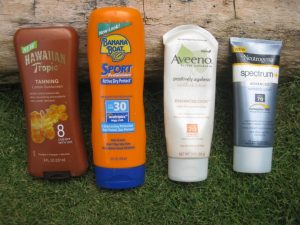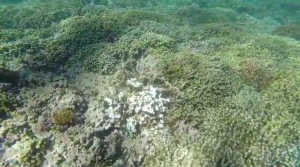“Reefs at Risk” The Effects of Sunscreen on Hawaiʻi’s Reefs
A short film, “Reefs at Risk – what’s in your sunscreen?” was released on Earth Day, Saturday, April 22, 2017, to raise awareness of the harm that certain chemicals, like Oxybenzone, does to Hawaiʻi’s reefs.
Since its release, the film has been viewed nearly 40,000 times and has been shared almost one thousand times on Facebook. It’s also been featured in a Washington Post Ad, a Mother Jones newsletter and was linked in an article in Vogue.
Filmed in January 2017, the scene is set on the beaches of Hawaiʻi, it explores the harmful effects some sunscreen chemicals have on coral and marine life. The film also discusses how reefs across the globe are dying at alarming rates.
Big Island Now was invited to take part in a webinar with the creators of the film, Malina Fagan and Lynn Pelletier, both Big Island residents, and with NOAA for more detailed information that the video doesn’t show.
The film discusses the importance of coral to Hawaiʻi’s ecosystem, it provides habitat, food, oxygen (almost as much as a rain forest), income from fishing and tourism, bio medical products and coastal protection from storms.
One statistic showed that approximately 14,000 tons of sunscreen enter waters around coral reefs each year and it’s estimated that 15% of the world’s coral reefs are impacted by sunscreen chemicals.
The film features Craig Downs, PhD and Executive Director of Haereticus Environmental Lab, he said, “We started noticing declines in our coral reefs around 1980-85, which is about the same time that personal care products like sunscreen were used prominently by tourists going to these beaches and visiting these coral reefs.”
Dr. Downs held up a sample of 20 drops of Oxybenzone, one of the most common ingredients in sunscreen, so viewers could understand the damage that one drop of the chemical could do to coral. “Oxybenzone can cause an adverse effect in coral at 62 parts per trillion, that is equivalent to one drop of water in six and a half Olympic size swimming pools, so you don’t need a lot to cause a lot of damage.”
Honour Booth, an ecotoxicology student at UH Mānoa, took a sample of the water at Waikīkī Beach to test for sunscreen chemicals. She said, “at certain times of day, you can actually see the sunscreen on the surface of the water.” She noted that the last time she tested the water in Waikīkī, there were twice as much concentrations of chemicals that is known to be harmful to coral.
The film says aerosol spray sunscreens are more harmful than sunscreen lotion because it travels and leaves residue in the sand, so when waves come in, it washes the sand and takes the residual ocean spray into the ocean. Fagan and Pelletier said during the webinar, “to quote the DLNR, ‘if you can’t say it, don’t spray it.’ Don’t use sprays at all because they get blasted all along the beach and into people’s lungs.”
A study of a small piece of coral from Trunk Bay in the US Virgin islands showed that when sprayed with one of the top aerosol brands, the coral lost all of it’s algae and turned white and bleached within 96 hours.
John Burns, PhD and coral biologist, who has worked on coral health and disease for nearly a decade, compared coral to humans. “They actually have a basic immune system that is a lot like humans, they react when they are being stressed out. When they’re white, their stressed, it’s a lot like us, when we’re sick, we’re pale and we’re not as healthy, and that’s what’s happening to the coral,” he said.
He added that he has seen reefs be completely wiped out due to bleaching.
According to the film’s creators, coral only grows 2 mm (0.078 inches) to 1 cm (0.39 inches) a year.
Scientists have shown that when coral spawn, the planula (baby coral) float to the surface of the water where they usually can float for thousands of miles, and in some cases come in contact with Oxybenzone. Scientists believe that one of the reasons they aren’t seeing new generations of coral coming in is due to visitors and sunscreen use.
Statistics have shown that coral reefs have declined 40% in the Great Barrier Reef, 85% in the Caribbean and 99% in the Florida Keys.
“When we take away the reef we’re taking away the habitat that is housing thousands of organisms,” added Dr. Burns. “These are literally some of the most effective eco-systems on the planet.”
Presentations in the webinar noted that coral reefs not only protect our shores and supply food and oxygen to our planet, but they are considered the rain forests of the sea.
Coral reefs cover less than 1% of the ocean floor, yet supports nearly 25% of all marine life.
“If we lose those reefs we lose a large amount of income from tourism, from biomedical products, from coastal protection and really important, to communities to food,” Dr. Burns added.
The film noted the value of coral reef is $9.9 trillion worldwide where the value of oil is $3.3 trillion.

Sunscreen labeling will have to change in 2012, in accordance with the FDA’s new regulations. Maui Now Photo
The webinar presentation showed a photo of a hand print on a large piece of coral that had stained the coral. A study showed that when coral comes into contact with Oxybenzone it can lower the temperature of the coral by 10 degrees, causing damage to its DNA and leaving reproductive issues in coral, sea urchins and other marine life.
“Tourism is Hawaiʻi’s number one industry, however, the marine environments around our islands are very fragile and so the more visitors that we have, the more of an impact they have on all of our beaches,” said Lisa Bishop, President of Friends of Hanauma Bay.
The film creators said that most people don’t realize that what we put onto our skin will eventually wash off and flow into the ocean, whether you’re at the beach or in the middle of the US. The women said, “people may not think about the coral while their jogging or at a soccer game and putting on sunscreen, but it all ends up going through a wastewater system and it all goes into the ocean.”
“Sewage is the biggest source of chemical sunscreen pollutants anywhere,” Dr. Downs said. “Twenty minutes after you put a sunscreen lotion onto your skin we can detect it in your urine. When you flush the toilet, all of that goes straight into sewage, out into a river, and then out into the sea.”
“Oxybenzone is a toxicant, it can cause harm to humans, mammals, and fish at particular concentrations,” he added.
Dr. Downs said mother dolphins are exposed to Oxybenzone all the time because it’s in the water polluting the marine environment and when the mother dolphin breastfeeds the Oxybenzone passes to the baby.
He said Oxybenzone also accumulates in human fat tissues and can transfer from the mother to the infant.
A study in the webinar showed a strong association between Oxybenzone levels in pregnant mothers and Hirshsprung’s disease in their newborn babies. The study also showed an increased rate of endometriosis (abnormal tissue growth of the uterus).
Hawaiʻi State Senator Will Espero tried to pass a bill this year to make Hawaiʻi the first state to ban the sale of Oxybenzone. However, the bill was not heard during this year’s legislative session and will be up for consideration again in 2018.
“We don’t even know the long term effect some of these chemicals can have on the human body, one can make a hypothesis that if a chemical is hurting coral, then that chemical could have a negative impact if it’s on a human body or skin for a certain amount of time,” Sen. Espero said.
The Centers of Disease Control showed that that Oxybenzone is found in 97% of Americans.
Although mostly found in sunscreen, Oxybenzone can also be found in lip balm, shampoo, moisturizers and foundations too. Some companies have even begun to phase Oxybenzone out of their products.
What sunscreens provide protection and are safe for the reefs?
Non-nano zinc oxide is one and it’s said to be the safest ingredient to be used in a sunscreen. A study showed two pieces of coral, one had contact with Oxybenzone the other with Zinc Oxide and Titanium Dioxide. The photo showed no effect to the coral that had contact with Zinc Oxide and Titanium Dioxide.
What’s the easiest thing visitors and locals can do when in the sun?
“Don’t put on sunscreens that have harmful chemicals on them, you can wear a long-sleeve rash guard, you can use lotions that don’t have that same impact, there’s little decisions like that, that if we all do it, it will collectively help this environment,” said Dr. Burns.
What else can we do to help keep our reefs safe?
“Buy safer products and educate others,” Fagan and Pelletier said, “Contact representatives, contact companies to reformulate their products, many brands are starting to phase out Oxybenzone out of their products.”
The ladies also said that some sunscreen manufactures claim to be reef safe when they are not. They said to avoid products that contain: Oxybenzone, Octinoxate, Oxtocrylene, Methoxycinnamate, Parabeans and Synthetic ‘fragrance.’
They advise to look for mineral based active ingredients like Zinc and Titanium Dioxide and to use only sunscreens labeled Non-Nano. “Although they may rub on a bit whiter, the don’t penetrate the skin, placenta or blood brain barrier,” they said.
Fagan is an investigative documentary filmmaker whose films about health, the environment and human empowerment have premiered in IMAX at the Denver Museum of Nature and Science, aired on PBS, and been selected at film festivals across the country, winning awards for their cinematography and storytelling. Originally from the Big Island, she holds a BFA in Film Production from Chapman University, where she participated in the highly selective “Destination Africa” program.
Pelletier has been a health practitioner for over 34 years and is a long time resident of the Big Island. Her commitment to raising awareness of environmental toxins and disease prevention, along with her background in chemistry and biology, makes her an invaluable resource in researching and developing health related films. She has been a story consultant on short documentaries ranging in topic from indigenous culture to the Hawaiʻi Volcanoes National Park.
For more information on chemical sunscreens click here.
Visit here for a list of safe sunscreens. Reef safe sunscreens can be found at local health food stores or at Target.
For the full video “Reefs at Risk”, click here.















